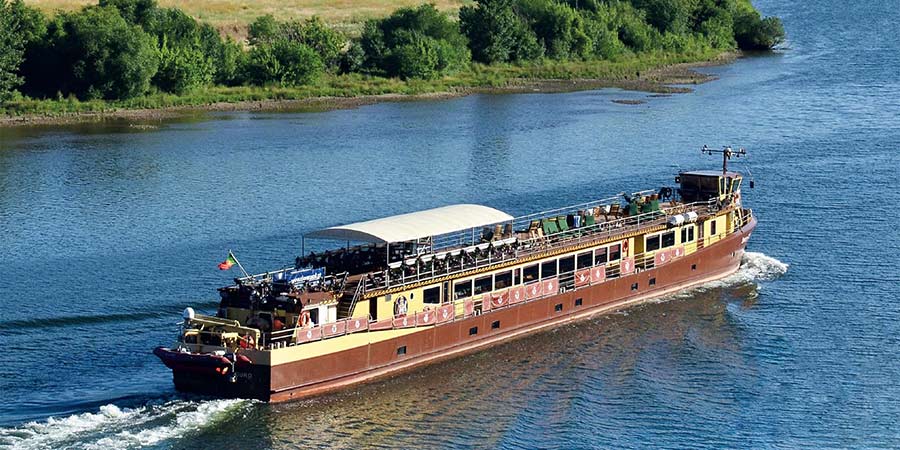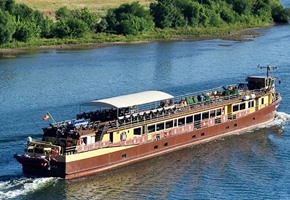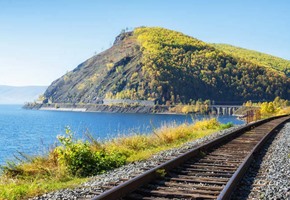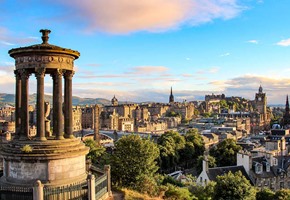It's 10.32 in the morning and I'm sat beneath the leafy boughs of a Portuguese arbour, sipping on delicate green wine made with grapes harvested from the very vineyard I'm looking out over. This is how life is in the Douro Valley, and with so many quintas to choose from you might as well start early and visit as many as possible. It's the first full day of our cruise aboard the Spirit of Chartwell, and so far I can definitely say that we've been receiving royal treatment. The next eight days stretching tantalisingly ahead of me, each one promising indulgence after indulgence as I lean back contentedly, listening to the estate's peacocks calling to one another and help myself to a generous chunk of locally made goats cheese that Maria assures us is the perfect pairing for this young vintage.
We boarded our ship back in the city of Porto, which all at once manages to be relaxed and vibrant. A waterfall of houses lines the riverfront, each a different height and colour and giving the area a whimsical feel for visitors, but which were a matter of life and death to the 16th century merchants who made a living selling their wares here. For them the bright hues acted like a multitude of lighthouses, guiding them safely into harbour. The playful feeling evoked today is only enhanced by the youngsters taking turns to dive into the clear water from the pedestrianised bridge, and the endless back and forth of the rabelos boats that journey up and down the river. Delivering barrel after barrel of port to the 25,000 local Port producers that have cellars here, they make sure the city never runs dry of its synonymous product. As we take a ride on the aerial gondola, a tip from our tour guide makes it easy to spot where each one is; all the Port houses have flat terracotta roofs to help moderate the temperature where they store their precious bottles of ruby and tawny liquid. We even get a free tasting included with our tickets, and make our way through the spindly streets that branch out from the main thoroughfare running alongside the Ribeira for our first (but very far from last) glass.
I have to be honest - before I came to Portugal I was not a fan of Port wine, a tipple that can only be made and named as such within the 557-mile radius that makes up the Douro Valley. But that was before I knew anything about how varied the flavours, body and aromas could be. My only experience, like many others I expect, came every December when my mum would pull out a bottle that had been opened many Christmases before, to accompany the cheese and crackers. It's safe to say the Portuguese take their Port a little more seriously however; on one night aboard we're lucky enough to see a time-honoured opening of a 30-year-old vintage. Much like the French flair for slicing the head off a bottle of Champagne with a sword, it's intended to avoid damaging the drink inside by keeping it from touching the disintegrating cork. In the deft hands of Anndreia, it looks easy but it's actually a technique that takes years to learn; heating up tongs over an open flame, applying them methodically to the neck, then dousing the delicate glass in ice-cold water to achieve a clean break.
As we're all cheering Anndreia on, I realise how quickly we've become a merry band of travellers and suddenly the whole concept of river cruising makes sense to me. From across the world we've come, Australia, Switzerland, America and the UK, to savour the delights of this quiet corner of the continent (at most we pass one or two other cruise ships a day, each cheerfully greeted by our captain with a toot of the regal horn). This sense of cohesion and joy is really brought home on our 2nd night, after a herculean effort making our way through a delicious seven courses of Portuguese inspired food from codfish, to chicken served with a smattering of passionfruit sauce. (Here it is only fitting to give a shout out to Adelmo, the Spirit of Chartwell's fantastic chef during our cruise who was headhunted after the owner ate at the restaurant he was working for previously). Whilst we're still indulgently digesting yet still having our wine glasses mysteriously replenished before they're even empty, we welcome into our fold a traditional band from the nearby town of Castelo Rodrigo, and it's not long before our full-to-bursting stomachs are forgotten as we careen around the saloon deck in a makeshift conga line. Someone has taken a triangle hostage, another has been invited up 'on stage' to show off their tambourine skills and we're all laughing like drains, having a royally raucous time of it. We don't have to worry about making too much noise either, as our mooring point tonight is home to only two other inhabitants; the boat hand Paulo and his mother.
Another day another vineyard, but Quinta de Aveleda feels that extra bit special. It's a crisp morning for July in Portugal, but that just helps with the ethereal atmosphere - the mist rolling over the hills creeps in like an old friend, before dispersing as the first of the day's sunlight reaches it. We're being shown around by the estate manager, a brusque woman who knows the intricacies of this family property like the back of her hand, and wants to make sure we do too. For example, who knew that cobwebs in wine cellars were actively encouraged? This means there are plenty of spiders around to eat the creepy crawlies that like to worm their way into wood, the kind of wood wine barrels are made from. And if you ever see a rose tree planted at the base of a grape vine, this is the vineyard version of the canary down the mineshaft - if the rose becomes diseased then it's the first sign of a dreaded grape phylloxera infestation.
As our cruise takes us ever closer to the border between Portugal and Spain, the scenery changes. From the lush, verdant terraces that were characteristic of our first couple of days sailing, now things are increasingly more arid and the scenery has morphed into a tapestry of olive and almond trees. The temperature climbing as we do, our coach makes a detour en route to Salamanca and clambering off the bus, we wonder what's brought us to this remote mountaintop. It takes a few minutes but soon we see them, elegantly riding the thermals like dancers in the sky against a backdrop of cotton wool clouds. Our guide Ana is clearly thrilled with the display they're putting on for us, these griffon vultures and red kites as they soar like synchronised swimmers above us. We have places to be however and more dancers to see, some who are surprisingly fiercer than birds of prey.
For anyone with a dislike of hearing other people eat, I highly recommend taking in a flamenco performance with your meal. The energy and passion of these women is enough to drown out even the noisiest of masticators, and I can see by glancing around me briefly in between sets that the rest of our group is as entranced as I am. While Regency ladies were demurely twirling around the ballrooms of Britain, in sun-drenched Spain the romanticism of emotional expression began to meld with cultures of a more bohemian nature, such as that of Andalucía and the far east, thanks to nomadic gypsies. What we're left with is pure flamenco, a word which can be translated appropriately as hell raising, and that will leave you wanting to stomp and clap your way across Salamanca as you explore its honey-coloured architecture and search (vainly in my case) for the city's lucky frog. With just one day to spend in Spain, this is the perfect place to do it. Food markets line the streets just outside of the golden city's main square, Plaza Mayor, all offering an array of enticing smells as they slice generous chunks of porchetta into crusty bread, (a great snack for the journey home, not that I need it) buskers serenade passers-by with rustic Spanish guitars, and café owners encourage you to try before you buy, something which enables me to nurture a new found love for Horchata.
All too soon though we're sailing west again, meandering sedately back towards Porto. The river becomes busier as we get nearer; water skiers impress us with displays of agility, fisherman line the banks in the hope of a bite, and families sprawl across sporadic stretches of beach. We can hear the city before we see it as the squawking of seagulls and ever-constant clang of church bells drift downstream towards us, heralding our sunset arrival. I go to bed that night knowing I'll miss curling up in my comfy cabin bed, and definitely miss the extravagant towel structures the house keeper (boat keeper is probably more appropriate) is so adept at. From my window I've seen some beautiful sights this past week; a skyfull of stars and the wispy trail of the milky way, a shoal of fish bathing in the light reflecting off the surface of the water - so much better than anything the television could have offered. The next morning our final breakfast before disembarkation is surprisingly emotional and there are plenty of hugs, exchanges of contact details and even gifts.
We're heavier, our suitcases are heavier but our cares have been lightened by an extraordinary week of captivating excursions, great food and even better wine, all supped to the soundtrack of the peaceful Douro.






